A preview of the papers appearing in the September 2006 issue of theJournal of the SID.
To obtain access to these articles on-line, please go to www.sid.org
Edited by Aris Silzars
Intelligent color imaging
Hiroaki Kotera
Chiba University, Japan
Abstract — With the 600th anniversary of Johann Gutenberg's birth in 2000 A.D., we should look back at the historical significance of letterpress technology and take a step forward into the new age of color imaging. Currently, digital-imaging technology plays a leading role in visual communications, but meets severe challenges to satisfy human vision. It is essential to consider what human vision "sees" in order to capture, store, transmit, and reproduce a truly realistic image just as human vision. Advances not only in high-precision and high-definition digital media but also in intelligent image-processing technologies will be helpful in producing more aesthetic and pleasant imaging. This paper briefly introduces "intelligent" processing towards that goal by using region-based spatially variant, and scene-referred approaches.
Recently, the advent of various flat-panel displays (FPDs) raised a curtain on the new display age. Current imaging devices meet two basic demands. One is high dynamic range (HDR) and other is wide color gamut. A novel CMS for FPDs will be needed. Because new devices such as LCDs or PDPs create a different gamut space than that of CRTs, the gamut mapping algorithm (GMA) is a key technology in making use of the display gamut for good color imaging. Figure 14 shows a simulation on how vivid colors are reproducible when the image gamut is expanded up to the gamut boundary of typical desktop displays.
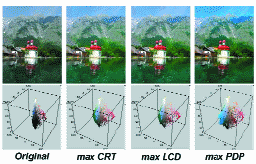
FIGURE 14 — Gamut expansion by histogram rescaling.
Effect of DLP projector white channel on perceptual gamut
Rodney L. Heckaman
Mark D. Fairchild
Rochester Institute of Technology, U.S.A.
Abstract — The effect of white-channel enhancement as implemented in the Texas Instrument DLP™ digital projector technology is evaluated theoretically using both the CIELAB and the CIECAM02 color appearance models and experimentally through psychophysical testing using real images. Both theory and test results confirm a compression of perceptual gamut in both chroma and colorfulness as a result of the added white channel. Hence, while this technology is ideal for viewing graphics and text under ambient conference-room conditions where lightness contrast is important, it is necessarily less than ideal for viewing images or in home-theater environments where color is important.
It is well known that adding white light to any color display media de-saturates its color. Yet, when confronted with a traditional gamut representation of such a media as a chromaticity diagram for a digital light projector (DLP), it is tempting to add a white channel to increase its luminance seemly without affecting its color gamut. This is good idea for those display applications where lightness contrast is important – applications such as the presentation of business graphics or textual information in a conference-room environment where viewing flare is a problem. However, a chromaticity diagram tells very little of the perceptual or appearance aspects of viewing. In those applications where color is important, e.g., digital video in a home-theater environment under dark viewing conditions.
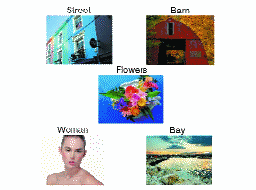
FIGURE 7 — Test images.
Effect of image size on the color appearance of image reproductions using colorimetrically calibrated LCD and DLP displays
Mahdi Nezamabadi
Roy S. Berns
Rochester Institute of Technology, U.S.A.
Abstract — Archiving images of cultural heritage based on spectral imaging techniques is an active research area in imaging science. Original and reproduced art are usually viewed under quite different viewing conditions. One of the interesting differences in viewing condition is size difference. This leads to different surrounds and adaptation states. In order to investigate the effect of size in color perception of rendered images, a visual experiment was conducted using a colorimetrically characterized digital projector and LCD. An image was rendered and projected on the screen. The same image was processed using various algorithms followed by rendering for the LCD. These LCD rendered images, by definition, were considerably smaller than the projected image. Using a paired-comparison method, the effect of image size was investigated using a colorimetric image of Georges Seurat's, "Sunday Afternoon on the Island of La Grande Jatte – 1884." The image rendered for an LCD with a linear increase in lightness resulted in a closer match to the image projected on screen than an original colorimetrically rendered image and was perceived as a more accurate reproduction than the majority of algorithms tested.

TABLE 3 — Summary of image-processing algorithms.
Electro-optical transfer function preferences for LCD TVs: The effect of display brightness andsurround illumination on preferred gamma
Justin Laird
Ethan D. Montag
Rochester Institute of Technology, U.S.A.
Abstract — Recent commercial liquid-crystal-display (LCD) televisions are larger and brighter than traditional televisions, thus impacting the viewing conditions in which they are viewed. These changes in viewing conditions may require different electro-optical transfer functions (EOTFs) for LCD TVs than those for conventional TVs. Here, the way various EOTFs affect the preferred image quality of test images with changes in brightness and surround illumination conditions are examined. The first method used a gain, offset, and gamma (GOG) function with a range of gamma values, and the second method altered the intrinsic EOTFs. Image preference for the simulated EOTFs was determined using a paired-comparison experiment for ten images. The first experiment took place in a darkened room at two display luminance levels. The results indicated that a gamma of 1.6 was most preferred overall although more so at a lower screen luminance level. In a second experiment, the procedure was repeated with a dim surround of 10% of the display's white point. With this surround, preference for a gamma value of around 1.6 at both screen luminance levels was more enhanced. These results indicated that image preference for different EOTFs is dependent on display luminance and that this dependence is maintained with a dim surround.
As displays approach the ability to reproduce real-world-scene intensities, it would be wrong to assume that strictly reproducing the original scenes physical contrast would provide sufficient fidelity. The effect of viewing environment will always necessitate some processing of scene contrast due to viewing parameters as seen here with display intensity and surround illumination. Likewise, our experiments were done at a fixed distance from the display. Due to the nature of the contrast sensitivity of the human-visual system, the relationship between size and perceived contrast is another parameter that can affect the choice of EOTF for optimal image quality. Finally, the increased sharpness of newer displays will affect image quality and the way images ought to be displayed.

FIGURE 1 — Schematic diagram of experimental room.
Contrast effect in evaluating the sense of presence for wide displays
Kenichiro Masaoka
Masaki Emoto
Masayuki Sugawara
Yuji Nojiri
NHK Science and Technical ResearchLaboratories, Japan
Abstract — To evaluate the relationship between visual angle and the sense of presence for wide displays, two experiments were conducted in which the visual angle (ranging from 30 to 100°) was manipulated as a between- and within-subjects factor, respectively. Two-hundred subjects participated in both experiments. In the within-subjects evaluation, presence scores increased as the visual angle widened, while those in the between-subjects evaluation did not increase significantly for a wide visual angle. It can be concluded that "contrast effect," i.e.,a bias caused by comparing different visual angles, greatly affects the ratings of sense of presence.
As is recommended for image-quality evaluation, the viewing distance in the experiments was set at 4.2 m, the point at which the structure of scanning lines is just discernable for those with 20/20 vision, known as the viewing distance for subjective assessment of image quality. Figure 7 shows a schematic depiction of the viewing condition in the two experiments. Under these viewing conditions, the visual angles for the five image sizes ranged from 33.2 to 100°. These experiments were conducted in a completely dark TV studio surrounded with black curtains.
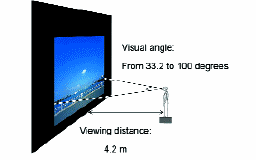
FIGURE 7 — Schematic depiction of the viewing conditions.
Threshold-voltage-compensation methods for AMOLED pixel and analog buffer circuits
Bo-Ting Chen
Ya-Hsiang Tai
Ying-Jyun Wei
Chun-Chien Tsai
Chun-Yao Huang
Yu-Ju Kuo
Huang-Chung Cheng
National Chiao Tung University,Taiwan, R.O.C.
Abstract — New pixel-circuit designs for active-matrix organic light-emitting diodes (AMOLEDs) and a new analog buffer circuit for the integrated data-driver circuit of active-matrix liquid-crystal displays (AMLCDs) and AMOLEDs, based on low-temperature polycrystalline-silicon thin-film transistors (LTPS-TFTs), were proposed and verified by SPICE simulation and measured results. Threshold-voltage-compensation pixel circuits consisting of LTPS-TFTs, an additional control signal line, and a storage capacitor were used to enhance display-image uniformity. A diode-connected concept is used to calibrate the threshold-voltage variation of the driving TFT in an AMOLED pixel circuit. An active load is added and a calibration operation is applied to study the influences on the analog buffer circuit. The proposed circuits are shown to be capable of minimizing the variation from the device charac-teristics through the simulation and measured results.
In order to reduce the current flow through the OLED during the reset period, a p-channel TFT5 used to block the emission current through the OLED was modified as shown in Fig. 6. Since the modified circuit can block current flow through TFT5 and the OLED, further power reduction can be obtained in the reset period as shown by the simulation results.
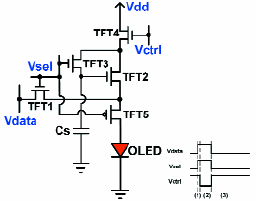
FIGURE 6 — Modified-pixel-circuit schematic and the timing diagram of control signals.
Development of a liquid crystal with fine-pitch light-source display (LFD) using an organic light-emitting diode (OLED)
Norio Koma
Manabu Takemoto
Kenji Tanase
Kazunobu Mameno
Sanyo Epson Imaging Devices,Corp., Japan
Abstract — A novel display system, refered to as an LFD (liquid crystal with fine-pitch light-source display) is proposed. In an LFD, an auxiliary light source patterned with a fine pitch is attached to a reflective liquid-crystal display (LCD), and a light shield is formed on the observer's side of the light source. A vertical-alignment LCD (VA-LCD) is attached as the reflective LCD, and an organic light-emitting diode (OLED) is attached as the fine-pitch light source. An LFD can produce bright, high-contrast images under any ambient light. A test sample was built and its display characteristics confirmed.
The principles of an LFD are shown in Fig. 2. Light emitted from the auxiliary light source is prevented from reaching the observer by the light shield, which emits only the reflective LCD on the side opposite the observer. When the voltage of the reflective LCD is off, the light emitted from the auxiliary light source does not reflect from the reflective LCD, so a black image can be obtained. When the voltage is on, the light reflects at the reflective LCD, and a white image is displayed. Because the emitted light does not pass to the observer's side, high-contrast images can be obtained. Because an LFD can use both the auxiliary and ambient light efficiently, it can produce bright images under any ambient light.
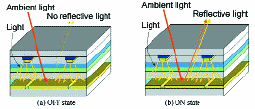
FIGURE 2 — Principle of an LFD.
Evaluation of chiral dopants for LCD applications
Monika Bauer
Christine Boeffel
Frank Kuschel
Horst Zaschke
Fraunhofer Institute IZM, Germany
Abstract — A large number of new synthesized as well as known chiral dopants with respect to their helical twisting power (HTP), the phase stability of cholesteric solution prepared by doping nematic LC mixtures, the host dependence of the chiral induction, and the photostability has been examined. The evaluation led to the result that only few compounds fulfill the stringent application requirements of LCD manufacturing, especially with reference to bistable cholesteric devices.
Although there is a huge number of optically active substances with or without the ability to form liquid-crystalline phases which has been recommended as dopants to prepare chiral LC phases from nonchiral nematic or smectic basic material, the application requirements of any actual case give occasion to a limiting selection. Of course, in order to prevent detrimental electro-optic property changes of the host material, chiral additives with high HTP values are favored. However, further relevant aspects, such as solubility, phase stability (especially at low temperatures), photochemical properties, and, last but not least, the chromatographic behavior of the doped material as a mobile thin layer between solid substrates must be considered.
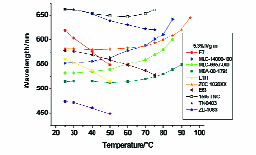
FIGURE 3 — Temperature dependence of the selective reflection of ten different nematic hosts containing 5.3-wt.% IVg.
Analysis and reduction of dark zone in ultra-thin wedge-plate displays
Yi-Kai Cheng
Sen-Nien Chung
Jyh-Long Chern
National Chiao Tung University,Taiwan, R.O.C.
Abstract — A wedge plate can be used as the screen of a display, and the thickness of the display can be incredibly thin. In this paper, a basic formula for ray tracing in such a wedge plate is deduced. The fundamental limitation on the display quality of a wedge plate is explored, and the formation of a dark zone on the display screen is analyzed and verified numerically. Experimental exploration and confirmation of one 14-in. acrylic wedge plate with a white-light-emitting diode is also provided. Two approaches to eliminate the dark zone are proposed, and the corresponding numerical demonstration of a 52-in. wedge-plate display is also shown.
A straightforward estimate suggested that a 2.5-in.-thick wedge-plate display could have a 50-in. screen diagonal, which means the ratio of the thickness versus the screen diagonal is 1:20. In other words, it is possible to have an ultra-thin display by using a wedge plate. In practice, the imperfection of the wedge media (including surface irregularity, absorption, scattering, and dispersion, etc.) would affect the image quality such as the contrast ratio. The dark zone is greatly affected, which is inherent in wedge-plate displays. The dark zone originates when the reflections of the output rays are different.

FIGURE 1 — Schematic diagram of a wedge-plate display, where D is the length of the screen diagonal (see text).
Design of a dual-f-number illumination system and its application to DMD™ projection displays
Chu-Ming Cheng
Jyh-Long Chern
National Chiao Tung University,Taiwan, R.O.C.
Abstract — A dual-f/# optical system is evaluated and considered for illumination. Étendue theory has been employed to increase the optical throughput and collection efficiency. A classical Cooke triplet with a dual f/# is included for illustration. As a demonstration of the potential application to projection displays, an elliptically shaped illumination-pupil system is proposed to increase the optical collection efficiency in the DMD™ (Digital Micromirror Device™)-based projection system. With a dual-f/# configuration, this design can eliminate the f/2.4 constraint that was caused by the light-steering action of the narrow ±12° tilt angles on the DMD™. The percentage of increase in the optical collection efficiency is 6.2% in the dual f/2.0 x f/2.4 optical projection system by using ray-tracing simulation. This method enables a lower than f/2.4 optical design with a high brightness and an adequate contrast ratio in the DMD™-based projectors.
The conceptual principle of the optical design in a DMD™-based projection system is to prevent the overlaps of on-, off-, and flat-state pupils for the high-contrast-ratio and high-quality-image controls. Because of the light-steering action of ±12°-tilt angles on the DMD™ mentioned above, the half-cone-angle of illumination light should be bounded within ±12° (i.e., a numerical aperture N.A. of 0.2079), which corresponds to the f/2.4 optical design in the illumination system. The constraint on the f/# is a critical factor that results in a low optical collection efficiency in a conventional DMD™-based projection system.
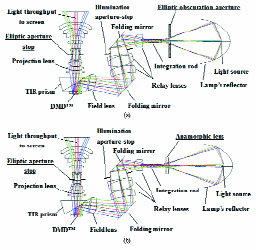
FIGURE 6 — Schematic diagrams of the optical system layouts for the elliptically shaped illumination-pupil design in the DMD™-based projection systems. (a) Elliptical obscuration-aperture design. (b) Anamorphic lens design, between the lamp's reflector and the integration rod.